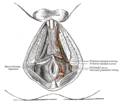| Ischiorectal fossa | |
|---|---|
 The perineum. The integument and superficial layer of superficial fascia reflected. (Ischiorectal fossa labeled at bottom left.) | |
 The posterior aspect of the rectum exposed by removing the lower part of the sacrum and the coccyx (ischiorectal fossa labeled at bottom right) | |
| Details | |
| Identifiers | |
| Latin | fossa ischioanalis |
| TA98 | A09.5.04.001 |
| TA2 | 2446 |
| FMA | 22059 |
| Anatomical terminology | |
The ischioanal fossa (formerly called ischiorectal fossa) is the fat-filled wedge-shaped space located lateral to the anal canal and inferior to the pelvic diaphragm. It is somewhat prismatic in shape, with its base directed to the surface of the perineum and its apex at the line of meeting of the obturator and anal fasciae.

